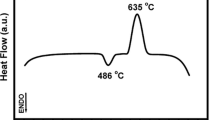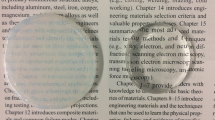Abstract
Borosilicate bioactive glasses containing titanium dioxide were prepared and investigated. The corrosion behavior of samples was examined for all samples upon immersion in phosphate solution. The erosion of the outer surface and ion exchange processes of the glass with the surrounding solution were studied by measuring the weight loss. Results were compared with samples that do not contain titanium dioxide. The final result of the reaction is the precipitation of hydroxyapatite. Characterization of the glasses was carried out by FTIR (Fourier transform infrared) absorption spectra before and after immersion in phosphate solution. The different crystalline phases and crystallographic parameters were explored using X-ray diffraction (XRD) analyzes and all indicate the precipitation of hydroxyapatite. A scanning electron microscope (SEM) is used to observe the morphological changes of the surfaces upon immersion. The atomic ratio of the final result product was obtained by the energy dispersive x-ray analysis (EDX) unit attached to the SEM. Changes in pH of the leaching solution were measured and evaluated. All measurements confirm that the studied glass has a high degree of biological activity which makes it very suitable for the field of biomaterials and other various medical applications.
Similar content being viewed by others
References
Hench LL (1991) Bioceramics: from concept to clinic. J Am Ceram Soc 74(7):1487–1510
El-Damrawi G, Doweidar H, Kamal H (2014) Characterization of new categories of bioactive based tellurite and silicate glasses. Silicon, 1–7
Kaur G et al (2014) A review of bioactive glasses: their structure, properties, fabrication and apatite formation. J Biomed Mater Res Part A 102(1):254–274
Rahaman MN et al (2011) Bioactive glass in tissue engineering. Acta biomaterialia 7(6):2355–2373
Abdelghany A, Kamal H (2014) Spectroscopic investigation of synergetic bioactivity behavior of some ternary borate glasses containing fluoride anions. Ceram Int 40(6):8003–8011
ElBatal FH, ElKheshen A (2008) Preparation and characterization of some substituted bioglasses and their ceramic derivatives from the system SiO 2–Na 2 O–CaO–P 2 O 5 and effect of gamma irradiation. Mater Chem Phys 110(2):352–362
Fu Q et al (2010) Silicate, borosilicate, and borate bioactive glass scaffolds with controllable degradation rate for bone tissue engineering applications. I. Preparation and in vitro degradation. J Biomed Mater Res Part A 95(1):164–171
Gu Y et al (2014) Biodegradable borosilicate bioactive glass scaffolds with a trabecular microstructure for bone repair. Mater Sci Eng: C 36:294–300
Jones JR (2013) Review of bioactive glass: from Hench to hybrids. Acta Biomater 9(1):4457–4486
Vollenweider M et al (2007) Remineralization of human dentin using ultrafine bioactive glass particles. Acta Biomater 3 (6): 936–943
Will J, Gerhardt L-C, Boccaccini AR (2012) Bioactive glass-based scaffolds for bone tissue engineering. Tissue Engineering III: Cell-Surface Interactions for Tissue Culture. Springer, 195–226
Rahaman MN et al (2008) Functionally graded bioactive glass coating on magnesia partially stabilized zirconia (Mg-PSZ) for enhanced biocompatibility. J Mater Sci: Mater Med 19(6):2325–2333
Li Y et al (2007) Conversion of bioactive borosilicate glass to multilayered hydroxyapatite in dilute phosphate solution. J Am Ceram Soc 90(12):3804–3810
Abdelghany A (2013) Novel method for early investigation of bioactivity in different borate bio-glasses. Spectrochim Acta Part A: Mol Biomolec Spectrosc 100:120–126
Liu X, Rahaman MN, Day DE (2013) Conversion of melt-derived microfibrous borate (13-93B3) and silicate (45S5) bioactive glass in a simulated body fluid. J Mater Sci: Mater Med 24 (3): 583–595
Mačković M et al (2012) Bioactive glass (type 45S5) nanoparticles: in vitro reactivity on nanoscale and biocompatibility. J Nanopart Res 14(7):1–22
Liu X et al (2013) Mechanical properties of bioactive glass (13–93) scaffolds fabricated by robotic deposition for structural bone repair. Acta Biomater 9(6):7025–7034
Silver IA, Deas J, Erecińska M (2001) Interactions of bioactive glasses with osteoblasts in vitro: effects of 45S5 Bioglass, and 58S and 77S bioactive glasses on metabolism, intracellular ion concentrations, and cell viability. Biomaterials 22(2):175–185
Singh K, Bala I, Kumar V (2009) Structural, optical and bioactive properties of calcium borosilicate glasses. Ceram Int 35(8):3401–3406
Cannillo V et al (2009) Thermal and physical characterisation of apatite/wollastonite bioactive glass–ceramics. J Eur Ceram Soc 29(4):611–619
Liu X et al (2009) Bioactive borosilicate glass scaffolds: in vitro degradation and bioactivity behaviors. J Mater Sci: Mater Med 20(6):1237–1243
Liu X, Rahaman MN, Fu Q (2013) Bone regeneration in strong porous bioactive glass (13-93) scaffolds with an oriented microstructure implanted in rat calvarial defects. Acta Biomater 9(1):4889–4898
Hu Y, Miao X (2004) Comparison of hydroxyapatite ceramics and hydroxyapatite/borosilicate glass composites prepared by slip casting. Ceram Int 30(7):1787–1791
Erol M et al (2012) Copper-releasing, boron-containing bioactive glass-based scaffolds coated with alginate for bone tissue engineering. Acta Biomater 8(2):792–801
Zhao S et al (2015) Copper-doped borosilicate bioactive glass scaffolds with improved angiogenic and osteogenic capacity for repairing osseous defects. Acta Biomater 14:185–196
Deliormanl AM, Rahaman MN (2012) Direct-write assembly of silicate and borate bioactive glass scaffolds for bone repair. J Eur Ceram Soc 32(14):3637–3646
Fu Q et al (2007) Preparation and bioactive characteristics of a porous 13–93 glass, and fabrication into the articulating surface of a proximal tibia. J Biomed Mater Res Part A 82(1):222– 229
Höland W, Rheinberger V, Schweiger M (2003) Control of nucleation in glass ceramics. Philos Trans Royal Soc London A, Math, Phys Eng Sci 361(1804):575–589
Monem AS et al (2008) In vivo behavior of bioactive phosphate glass-ceramics from the system P2O5–Na2O–CaO containing TiO2. J Mater Sci: Mater Med 19(3):1097–1108
Zhang X, Chen X, Li B (1997) Effect of heat-treatment and TiO2 addition on the crystallization features of bioactive glass ceramics. J Trace Microprobe Tech 15(4):713–716
Abdelghany A et al (2016) Role of SrO on the bioactivity behavior of some ternary borate glasses and their glass ceramic derivatives. Spectrochim Acta Part A: Mol Biomol Spectrosc 152:126– 133
Liu X et al (2009) Bioactive borosilicate glass scaffolds: improvement on the strength of glass-based scaffolds for tissue engineering. J Mater Sci: Mater Med 20(1):365–372
Abdelghany A, ElBatal H, EzzElDin F (2012) Bone bonding ability behavior of some ternary borate glasses by immersion in sodium phosphate solution. Ceram Int 38(2):1105–1113
Author information
Authors and Affiliations
Corresponding author
Rights and permissions
About this article
Cite this article
Kamal, H., Hezma, A.M. Structure and Physical Properties of Borosilicate as Potential Bioactive Glasses. Silicon 10, 851–858 (2018). https://doi.org/10.1007/s12633-016-9540-7
Received:
Accepted:
Published:
Issue Date:
DOI: https://doi.org/10.1007/s12633-016-9540-7




